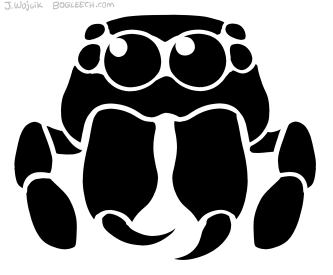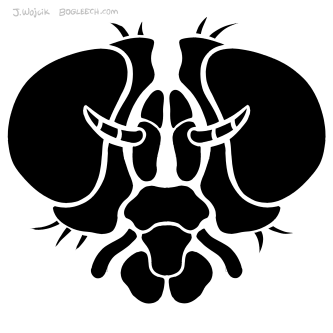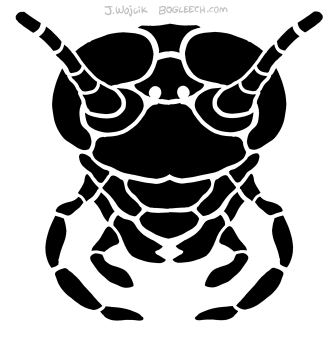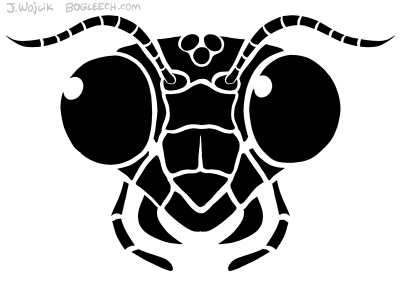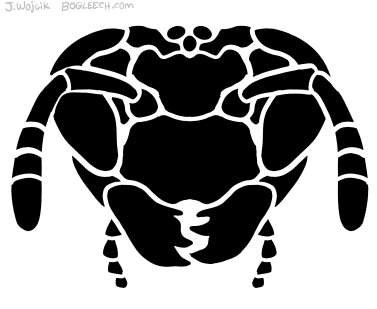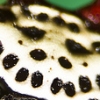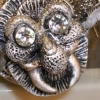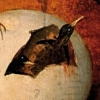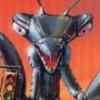Written by Jonathan Wojcik
October 8: ARTHROPOD PUMPKIN STENCILS!
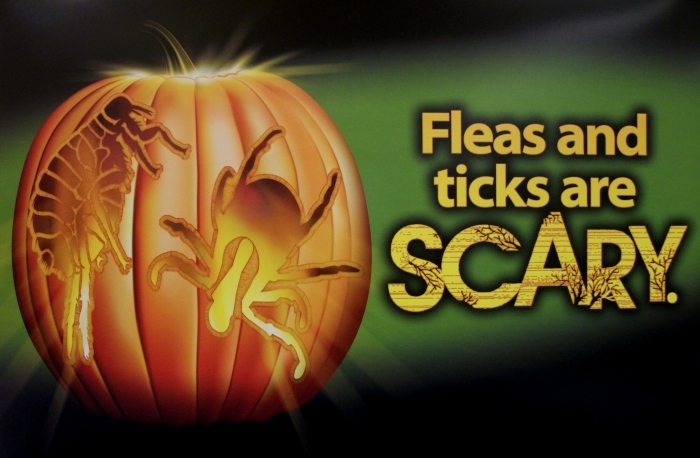
So Advantix (or something) is running an ad campaign I can really get behind this year, with these adorable little signs on display in Petsmart. I totally want one just to hang on my bedroom wall (anyone out there a Petsmart employee?) but as impressive as the flea looks, I knew right away I could design a better tick (even if theirs looks a little like an upside-down Mr. Harvestman), which in turn got me thinking more and more on the topic of insect and arachnid pumpkins. I've seen quite a few each year, but the vast majority tend to just be carvings of entire spiders.
There's certainly nothing wrong with entire spiders, no, but I've always leaned a bit more towards Jack O' Lanterns that focus on the face, and our many-legged friends are only ever more handsome in close-up. Thus, I've decided to draw up my very own set of insect and arachnids face patterns for use as pumpkin carving stencils, which you're free to print out and try for yourself! If you've never carved a pumpkin with a stencil before, Ehow explains, and if you happen to carve one of mine, I would love to see photos!
Jumping Spider
Click for hi-res printable!
The Salticidae or jumping spiders are by far some of our planet's cutest tiny predators; anyone who's met one knows how much personality they seem to show in their inquisitive little stares. Some species display complex problem solving skills, planning and learning far beyond that demonstrated by the other arachnida.
Blowfly
Click for hi-res printable!
Personal favorite animals of mine, common blowflies or flesh flies are major decomposers around the globe, recycling the dead back into the food chain and helping keep our planet clean. Lacking the anatomy to chew, they instead regurgitate digestive enzymes into a sponge-like pad, liquefying food externally and mopping it back up.
American Cockroach
Click for hi-res printable!
Remarkably clean and generally harmless to all but their fellow insects, cockroaches or Blattodea are most (in)famous for their tenacity, a handful of species even thriving in the desolate linoleum, plaster and concrete nests of Homo sapiens. Even when the paranoid apes douse their own homes with poison, household roaches can bounce back stronger than ever.
Preying Mantis
Click for hi-res printable!
The fiercely predatory Mantodea or mantids share immediate common ancestry with the cockroaches, the two more or less as closely tied as apes and monkeys. The female's famous reputation for killing and cannibalizing the male after mating is largely misconception, occuring only rarely in the wild - when she just happens to be really hungry.
Yellow Jacket
Click for hi-res printable!
I hear a lot of people say that if they could rid the world of jut one life form, it would be wasps. Why something deserves such violent hatred just for having a really good defense mechanism is beyond me - I guess we don't like anything in nature that can stand up to our bullying. The truth is, wasps are of enormous benefit to the ecosystem as the most specialized natural predators and parasites of caterpillars, aphids and other leaf-eating, sap-sucking insects. Many forms of plant life even boast unique chemical distress signals to call specific wasps to their aid, and few species are interested - or seldom even capable - of stinging us larger vertebrates. Still, if there's one thing you don't want to mess with in the wild, it's a nest of yellow jackets.
Dog Tick
Click for hi-res printable!
Finally, here's that improved full-body tick I was talking about. Ticks are rather special to me as the one and only animal I have ever suffered an unreasonable phobia towards. It's not even the risk of disease, but an irrational dread of unexpectedly finding one embedded in my flesh, which has actually yet to ever happen to me. They're still among my favorite little weirdos, of course, and I'm probably long overdue to devote an article to their strange adaptations. With four pairs of legs, ticks are arachnids just like spiders, and in fact, the very largest of all mites!
HALLOWEEN 2012 ARCHIVE:

